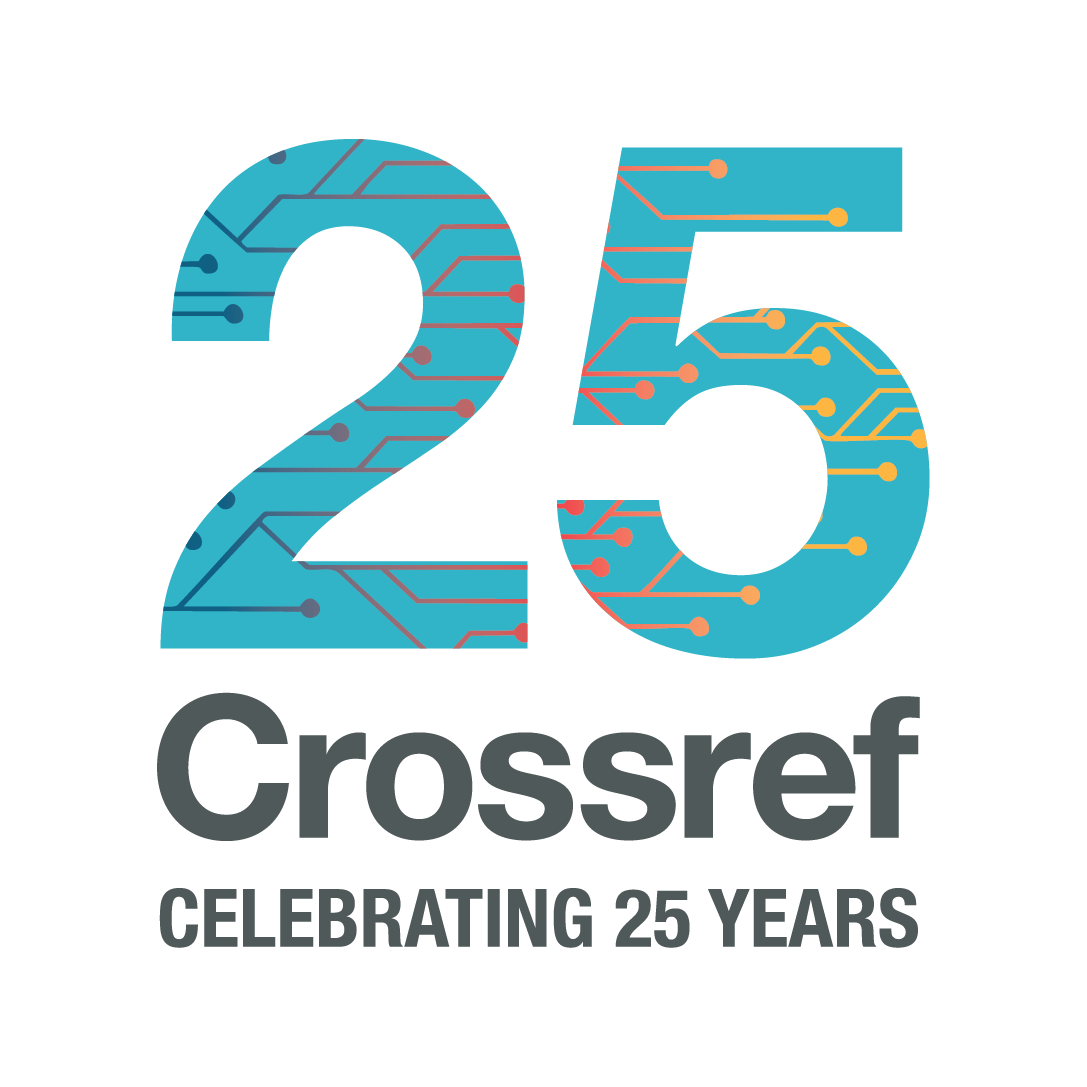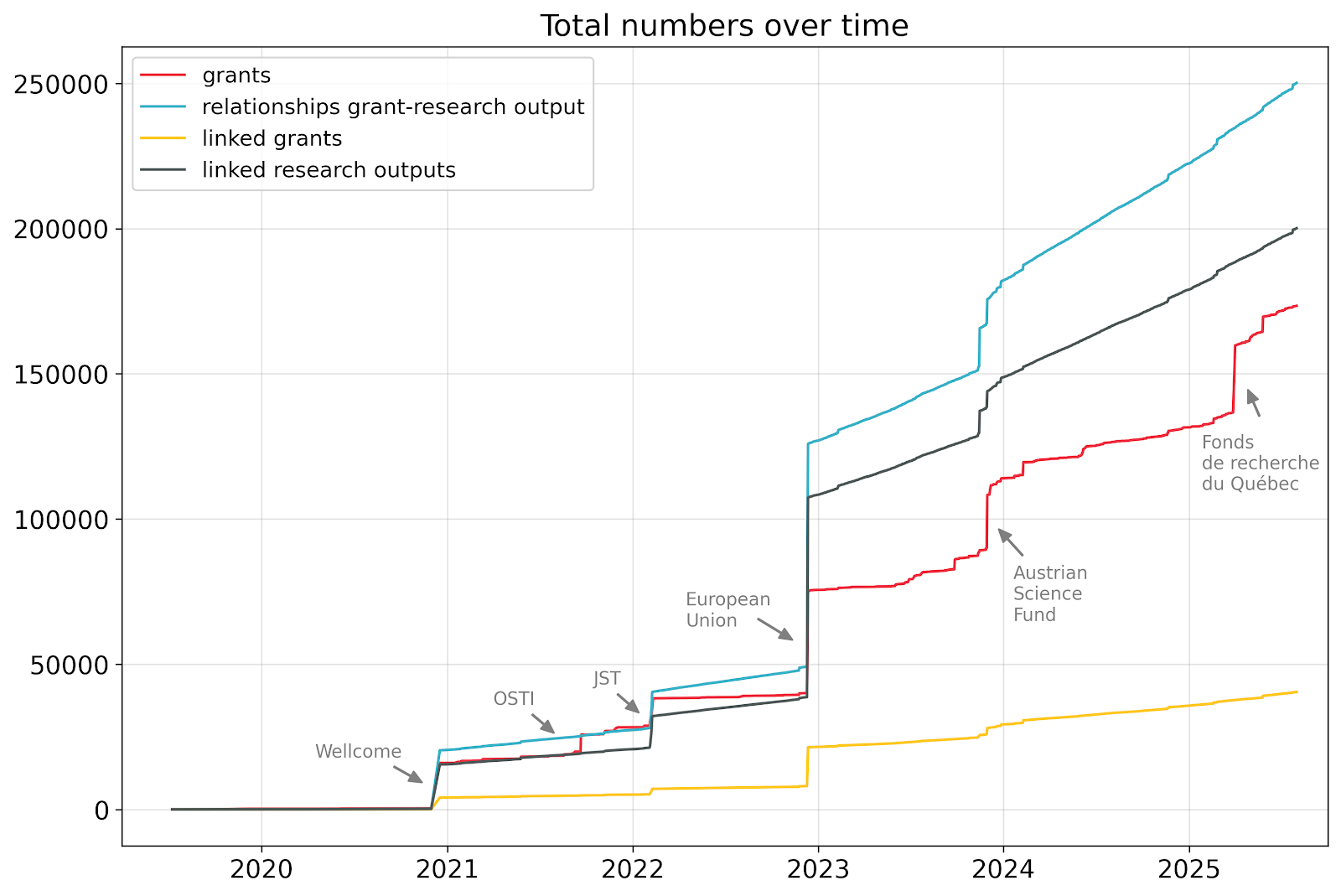8 minute read.Piecing together the Research Nexus: uncovering relationships with open funding metadata
The Crossref Grant Linking System (GLS) has been facilitating the registration, sharing and re-use of open funding metadata for six years now, and we have reached some important milestones recently! What started as an interest in identifying funders through the Open Funder Registry evolved to a more nuanced and comprehensive way to share and re-use open funding data systematically. That’s how, in collaboration with the funding community, the Crossref Grant Linking System was developed. Open funding metadata is fundamental for the transparency and integrity of the research endeavour, so we are happy to see them included in the Research Nexus.
As emphasised recently by Hans de Jonge from NWO, funding metadata’s value is in the transparency of the relationships it enables. The system is powered by the collective action of the research community– including research funders – that registers open metadata with Crossref, making these relationships possible. With close to 180,000 grant records in our corpus we wanted to know how far they reach and what story they tell.
In March 2022, we developed an approach for linking grants to research outputs and analysed how many such relationships could be established. Now we’re able to present the latest dataset that contains relationships between grants and research outputs, both those deposited by Crossref members and discovered by an automated matching strategy. It includes data deposited up to the end of July 2025.
This work is part of our ongoing Metadata Matching project.
What exactly is in this new open dataset of grant<>output relationships?
- The dataset contains 250,163 total funding relationships between grants and research outputs.
- We welcomed a number of funders, such as the Dutch Research Council and Fonds de Recherche du Quebec, which together registered almost 27,000 grants in the past year.
- It’s clear that the more grant metadata is registered the more funding relationships we can uncover.
- The percentage of relationships that are registered explicitly by Crossref members providing grants IDs in funding information has grown from less than 0.1% in 2023 to 1% (modest numbers but amazing growth!).
The methodology
We created a dataset of relationships between grants and research outputs by analysing their metadata in several ways. A relationship is included in the dataset if at least one of the following conditions is met:
- A relationship was explicitly deposited by a Crossref member through a finances or isFinancedBy relationship: 488 (0.2%) relationships
- The research output contains the grant DOI within the award number in the funding metadata: 2,003 (0.8%) relationships
- The award numbers in the grant and the research output are similar, and the associated funding organisations are either the same, or one is the sub-organisation of the other: 247,672 (99%) relationships
The dataset includes data deposited until the end of July 2025 and contains 250,163 total relationships.
The code used to generate the dataset is available in our GitLab repository.
The results
As you can see in the graph below, the number of relationships grant-research output continues to grow as the number of grants records Crossref members register with us increases.
Figure 1: Cumulative totals of grants, linked grants, research outputs, and grant–research output relationships from 2019 to 2025. Stepwise increases correspond to the addition of major funder datasets, including Wellcome (2020), OSTI (2021), JST (2022), the European Union (2022), the Austrian Science Fund (2023), and the Fonds de recherche du Québec (2025).
Looking at the numbers broken down by grant registrants we can see that the more grants registered the more relationships can be uncovered. The table below shows funders who have at least 1,000 total grants registered and for whom at least 10% of their registered grants are linked to research outputs, showing the number of relationships, grants, linked grants and linked research outputs (sorted by the percentage of linked grants), and compared with the data from the 2023 analysis (where available) to see how the uptake of open funding metadata is evolving.
| Funder | Relationships | Linked research outputs | Grants | Number of linked grants | Percentage of linked grants |
|---|
| 2023 | 2025 | 2023 | 2025 | 2023 | 2025 | 2023 | 2025 | 2023 | 2025 |
|---|
| European Union | 86,979 | 128,572 | 78,576 | 114,491 | 39,703 | 53,473 | 14,860 | 21,402 | 37.4% | 40% |
|---|
| Japan Science and Technology Agency | 19,549 | 30,728 | 16,265 | 25,003 | 9,923 | 11,866 | 2,609 | 3,900 | 26.3% | 32.9% |
|---|
| Wellcome | 34,254 | 45,596 | 25,720 | 33,783 | 17,547 | 19,929 | 5,238 | 6,206 | 29.9% | 31.1% |
|---|
| American Cancer Society | 50 | 604 | 49 | 586 | 380 | 1,162 | 34 | 277 | 8.9% | 23.8% |
|---|
| American Heart Association (AHA) | 40 | 1,040 | 38 | 935 | 598 | 2,764 | 30 | 621 | 5% | 22.5% |
|---|
| Fundacao para a Ciencia e a Tecnologia | 0 | 27,915 | 0 | 15,681 | 5 | 17,422 | 0 | 3,793 | – | 21.8% |
|---|
| Austrian Science Fund (FWF) | – | 10,387 | – | 7,459 | – | 19,576 | – | 2,712 | – | 13.9% |
|---|
Table 1: Comparison between data from 2023-07-31 and 2025-07-31 of a number of Crossref members registering grants. It shows the number of relationships, grants, linked grants and linked research outputs, sorted by the percentage of linked grants.
We encourage funders to join as members once they have determined the means of effective implementation of the GLS within their processes. By further analysing metadata of matched outputs, funders have the opportunity to monitor compliance with their policies and learn more about the impact of their programs.
Following through funders’ Open Science commitments
The relationships showcased above and in the recent analysis are powered by open funding metadata. Open funding metadata plays a central role in building a transparent, accountable and high integrity research environment by making visible the connections between the funding, grantees, research outputs, and their impact. Funders’ openness mandates and Open Science commitments emphasize the importance of traceability in the research process, so ensuring that the support given-whether financial or otherwise-can be systematically recorded and shared is instrumental. Openness is also part of the strategic plans of institutions such as the International Science Council, who has explicitly called for greater transparency in funding as a way to strengthen trust in science and counter misinformation. At the same time, initiatives such as the Barcelona Declaration on Open Research Information underscores the benefits of open, reusable funding metadata for monitoring, evaluation and assessment of research and researchers.
Crossref’s Grant Linking System offers funders’ a way to demonstrate a commitment to openness, modeling the standards they expect of the research community they support, while creating a more robust, trustworthy and collaborative research ecosystem.
Economy of scale: unlocking relationships with Crossref
Crossref houses millions of records, from the ubiquitous research articles and preprints, to books, peer review records, technical reports, datasets – you name it. Our members not only register, but also regularly update their metadata as new or corrected information becomes available. Our matching workflows allow us to make visible the hidden relationships and complete and improve the metadata records by adding new and reciprocal assertions.
This analysis shows the unique value of registering funding metadata with Crossref and adding an essential piece to the Research Nexus puzzle. The relationship metadata allows the funding that underpins the research process to be connected, and contextualise scattered data points, acting as an anchor that links publications, people, and other research outputs. This is made possible by the impressive number of records continuously being registered by more than 23,000 member organisations, and by the increasing availability of funding information in the system with more research funders joining in and registering their grant metadata with us.
Next steps
As we welcome more and more funders to the GLS, we, collectively, continue to complete the Research Nexus, record by record, field by field. The more awards we have in our corpus the more relationships we’ll uncover, so we’ll keep making these analyses periodically to make sure we don’t miss them.
But it is not all on us. We are working towards a vision where Crossref Grant IDs are business as usual – where funders register their awards, grantees are aware of them and share them with publishers, and those publishers share them back with us when registering their content – closing the loop organically. We continue working on making this easier. In the upcoming works schema update a specific Crossref Grant ID field will be added in the funding information, alongside Award ID (for an internal identifier).
Crucially, as the momentum of adoption among funders increases, and thousands of Crossref Grant IDs are available in the system, we are working with all members to raise their attention to the importance and desirability of funding metadata, so inclusion of that information in metadata of all works increases and consequently, the percentage of relationships asserted by Crossref members can grow.
This matching analysis is just one example of what we do to enrich metadata to highlight relationships among works, individuals, institutions, and actions. Earlier this year, we launched the Metadata Matching project, which is a major effort to rebuild our matching workflows using modern software development and data science practices. As part of the project, we plan to expose additional matched relationships between grants and research outputs in our REST API, alongside those deposited by our members. We’ll keep you updated as we go along!
Read more about metadata matching in the blog series:
Further reading
- Oct 15, 2025 – Integrating grant metadata for seamless research interconnectivity at FCCN|FCT
- Sep 9, 2025 – Celebrating one year of Crossref Grant IDs at NWO
- Jul 23, 2025 – Connecting the dots: FWFs transition to linked grant metadata to support a thriving culture of openness
- Feb 22, 2023 – The more the merrier, or how more registered grants means more relationships with outputs
- Nov 17, 2022 – How funding agencies can meet OSTP (and Open Science) guidance using existing open infrastructure
- Mar 22, 2022 – Follow the money, or how to link grants to research outputs
- Dec 13, 2017 – Global Persistent Identifiers for grants, awards, and facilities
- Nov 5, 2025 – Announcing changes to REST API rate limits







